Lung Information You Need to Know (Infographic)
If you have chronic obstructive pulmonary disease (COPD), or other lung issues, we want you to know the treatment you might encounter. Here’s an easy-to-understand infographic below to help.

If you have chronic obstructive pulmonary disease (COPD), or other lung issues, we want you to know the treatment you might encounter. Here’s an easy-to-understand infographic below to help.

Washing your hands often with soap and water for at least 20 seconds can drastically reduce your risk for illness, according to the CDC. Good hand-washing hygiene is especially important after you have been in a public place, or after blowing your nose, coughing, or sneezing. If soap and water are not available, use a hand sanitizer that contains at least 60% alcohol.
Download the How to Wash Your Hands (Infographic)

Cardiovascular diseases are the number one cause of death in the world. We’ve created this infographic to help you understand risk factors, warning signs and certain treatment options.
Download the Heart Information You Need to Know (Infographic)
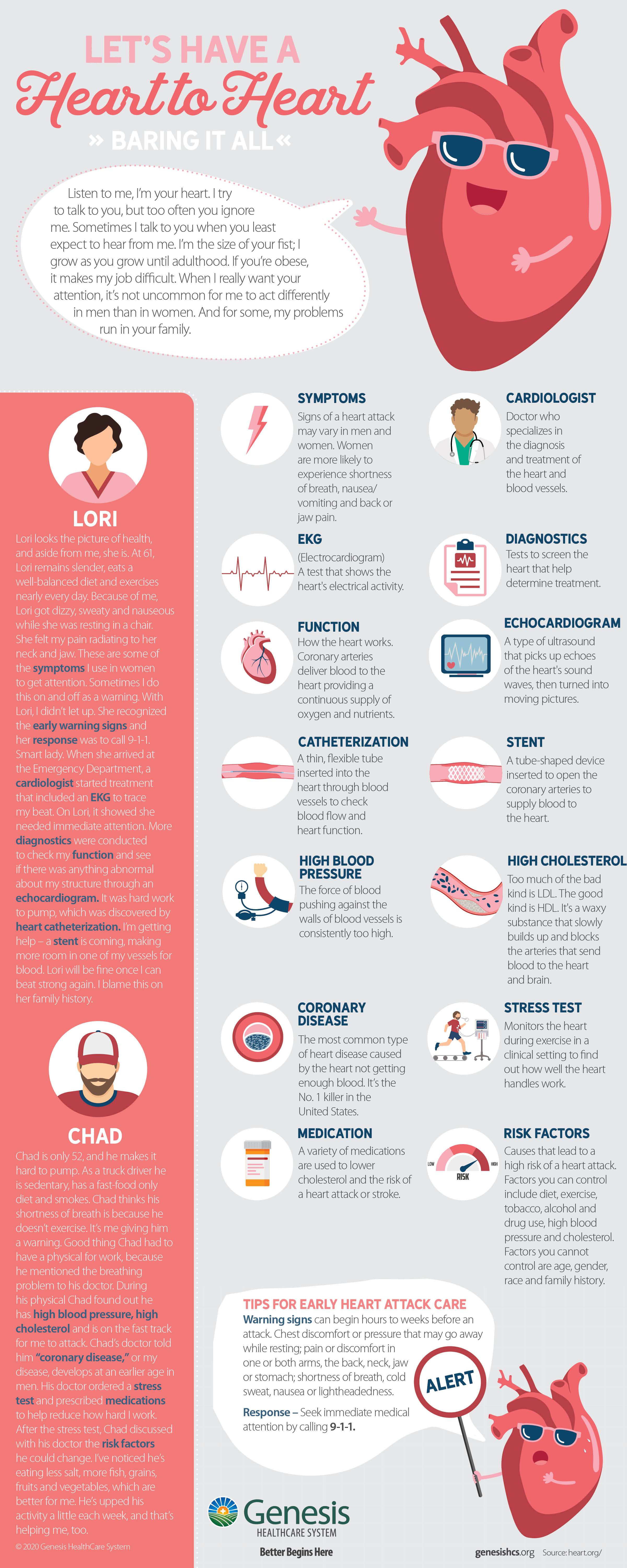
Health screenings play a vital role in your long-term health. They can help catch diseases in the early stages and improve your chances of recovering. Read the infographic below to learn what you should typically be screened for and when.
Download the guide to health screenings through the years (Infographic)
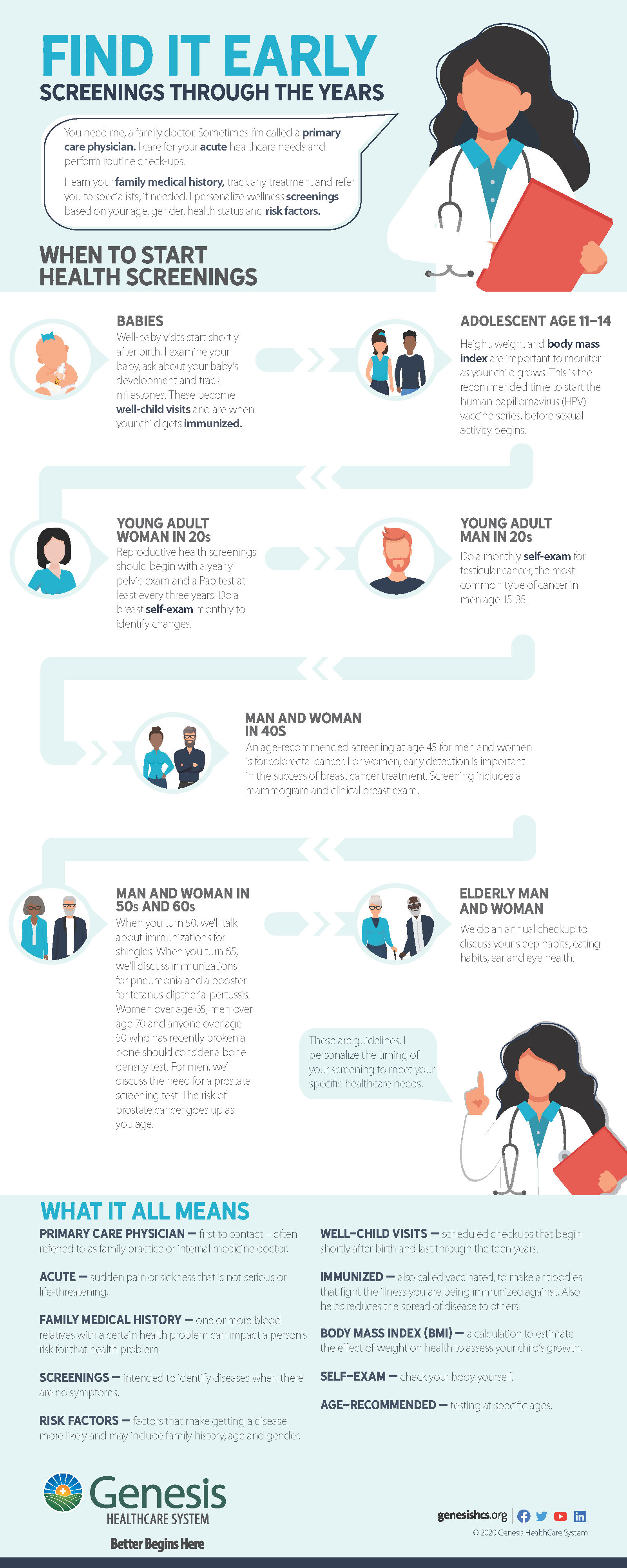
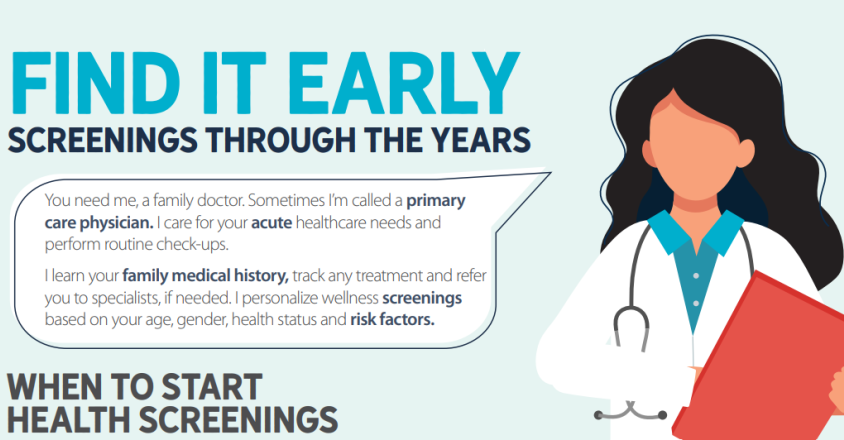
If this description resonates with you, you may be a member of Generation X, also known as “America’s neglected middle child,” the boomerang generation and the sandwich generation. Generation X adults were born between 1965 and 1980, after the infamous Baby Boomers and before Millennials, the largest generation in history.
Your late 30s and 40s are a time of transition. Some of the indicators of heart health — such as blood pressure, waistline and cholesterol — may begin to creep upward, putting you on notice that you cannot take your heart health for granted. You’ll also start noticing normal signs of aging, including graying hair, thinning skin and even your first few wrinkles.
> Generation X: 5 Health Risks You Need to Know About (Infographic)

Sleep. We all need it. But few of us consistently sleep as long — or as restfully — as we should for optimum health.
In this infographic, learn eight tips to get your eight hours of sleep each night and six bedtime snacks that contain the right combination of proteins and carbohydrates to get you ready for bed tonight.
Download the 8 Tips for Better Sleep Infographic (PDF)

Download the 8 Tips for Better Sleep Infographic (PDF)
There are four key measurements of health you should know and track. They are early warning signs for heart disease and diabetes. Since these two diseases have few noticeable symptoms, you may not even realize you are ill — or at risk for becoming ill — until it’s too late. Keeping these numbers within a healthy range can help prevent a medical emergency, such as a heart attack.
Cholesterol is a soft, waxy substance found in every cell in your body, including blood cells. Too much cholesterol may accumulate on your blood vessel walls, where it can harden and turn into plaque. This may narrow your blood vessels, reducing blood flow and putting you at risk for heart disease.
There are different types of cholesterol. You’ve probably heard of “good” cholesterol (HDL, or high-density lipoproteins), “bad” cholesterol (LDL, or low-density lipoproteins) and triglycerides (a form of fat that can raise your cholesterol levels). All three, plus your total cholesterol, are important.
Heart experts recommend the following healthy blood cholesterol levels. You want to measure cholesterol after fasting for nine to 12 hours.
Total cholesterol < 200 mg/dL (milligrams per deciliter)
HDL cholesterol > 60 mg/dL
LDL cholesterol < 100 mg/dL
Triglycerides < 100 mg/dL
Blood pressure measures the pressure in your arteries when your heart beats (systolic pressure) and in between beats (diastolic pressure). Your blood pressure is your systolic pressure over your diastolic pressure. If you have high blood pressure, also known as hypertension, your heart must work harder than normal, which can lead to heart disease, stroke and other serious conditions. A normal blood pressure is generally considered less than 120 systolic and less than 80 diastolic. Talk to your doctor about the right target blood pressure goal for you.
People with diabetes have to much sugar (glucose) in their blood. Diabetes is a serious disease, affecting nearly 30 million people in the U.S.
Your doctor can perform several tests to measure your blood glucose. The fasting plasma glucose test (FPGT) and the oral glucose tolerance test (OGTT) require you to fast beforehand. The A1C measures average blood glucose over the previous three months and does not require fasting. Normal blood glucose levels are typically:
FPGT < 100 mg/dL
OGTT < 140 mg/dL
A1C < 5.7 percent
Obesity, especially in the form of extra fat around your midsection, is a significant risk factor for heart disease and diabetes, so your weight, body mass index (BMI) and waist circumference together make up the fourth key health measurement. BMI is a rough measure of the amount of fat in your body based on your weight and height. Use this chart, use an online calculator or ask your doctor to determine your BMI. A normal BMI is between 18.5 and 24.9. Your waist circumference should be less than 35 inches (women) or 40 inches (men). Measure your waist just above your hipbones and immediately after exhaling.
Do One Thing: Know your numbers. Get a baseline measurement of these four health markers and talk to your doctor about your disease risk factors.
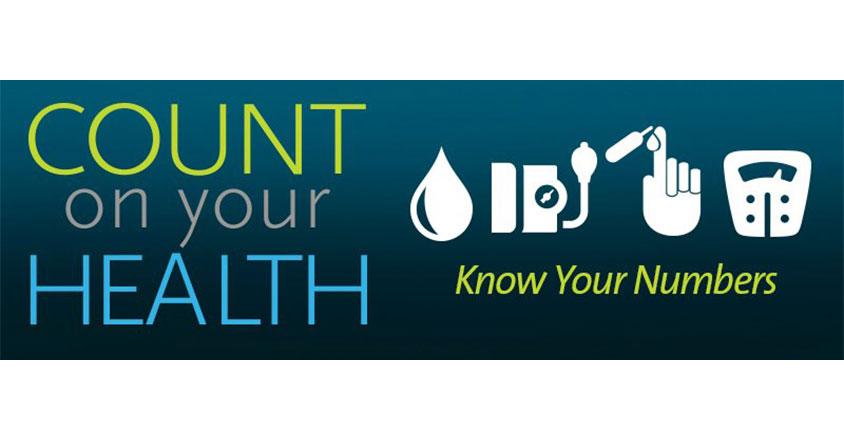
There are four key measurements of health you should know and track.
COVID-19 can cause a wide range of emotions that may include anxiety, isolation, anger and more. This is normal. Countless people are feeling the same way. Below are suggestions from the Centers for Disease Control and Prevention (CDC) for dealing with these feelings and keeping yourself healthy.
For community health information, rely on your local health department. For information on a larger scale, visit the CDC website. Don’t panic because of a social media post or a story on a questionable website. If the information is real, trusted news sources will verify it.
Be mindful of how long you spend watching and listening to COVID-19 coverage. Obsessing over it can increase anxiety.
Frequently and thoroughly wash your hands with soap and water or an alcohol-based hand sanitizer. Avoid touching your face. Cover your mouth and nose with a tissue or sleeve when you cough or sneeze. Avoid individuals who are sick.
Get plenty of rest, exercise, eat healthy and avoid alcohol and drugs. Do things that you enjoy. Read a book, watch a movie at home, or play a game with loved ones.
Talk to and text friends and family over the phone. Connect through social media. Be honest with loved ones about how you are feeling.
If the pressure is too much, contact The Genesis NurseLine 24 hours a day, seven days a week at (740) 455-4949 or Genesis Behavioral Health at (740) 454-4615 for resources to deal with the stress.

Lung cancer. Just mentioning the condition may increase fear and loss of hope — and for good reason. Lung cancer kills more Americans every year than the next three most common cancers — breast, colon and prostate — combined, according to the American Cancer Society.
But even as the most commonly diagnosed cancer worldwide (excluding non-melanoma skin cancer), with 2.1 million new cases in 2018, it’s important to understand the myths and facts surrounding lung cancer, according to hematology and oncology specialist Shyamal R. Bastola, M.D., Genesis Cancer Care Center.
“There are three important messages about lung cancer we need to focus on: prevention, understanding increased risk and how we can decrease that risk, in addition to knowing there’s a tremendous improvement in treatment options,” Dr. Bastola explains. “It’s both the personalized prevention and treatment that has changed what we think of lung cancer.”
To help overcome the unknown lung cancer often represents, Dr. Bastola provides much-needed insight on the myths and facts behind the condition:
Fact: While most lung cancer cases are related to smoking, nonsmokers can get lung cancer, too. Causes of lung cancer in non-smokers include secondhand smoke, or smoke from burning tobacco products and smoke that has been exhaled by the person smoking.
Environmental exposure to certain hazardous chemicals including asbestos, uranium, arsenic and some petroleum products, in addition to air pollution can also cause lung cancer in nonsmokers. “Radon exposure has also been shown to be the second-leading cause of lung cancer,” states Dr. Bastola. “Anything that causes chronic irritation of the lungs increases the risk of lung cancer, with the same concept applying to vaping, where there is good data showing it can cause significant lung damage.”
Fact: While lung cancer is an equal opportunity disease, with the American Cancer Society estimating about equal numbers of new cases for both men and women in 2020 (116,300 in men and 112,520 in women respectively), invasive breast cancer remains the biggest threat to women. In fact, it’s projected 276,480 women will be diagnosed with invasive breast cancers in 2020. “Lung cancer may present an increased risk over breast cancer for women in terms of dying, but breast cancer remains the most common cancer diagnosed among women in the United States,” Dr. Bastola explains.
Fact: It’s true lung cancer does not show obvious symptoms until it reaches an advanced stage, yet timely detection is aiding early diagnosis and successful treatment.
Cancer has five stages: stage 0 (carcinoma in situ, or a tumor that is confined to its site of origin and has not invaded neighboring tissue or gone elsewhere in the body), stage 1, stage 2, stage 3 and stage 4. Lower stages indicate the disease is more localized, or contained, whereas higher stages refer to cancers that have spread into other areas of the body. Due to obvious symptoms including a cough that won’t go away, coughing up blood or significant weight loss not obvious until later, 75% of lung cancers are diagnosed when the disease is advanced or has spread to a new part of the body (metastasis).
But, those at high risk of the disease can greatly benefit from a screening test called a low-dose computed tomography (also called a low-dose CT scan). This screening is recommended for adults between the ages of 55 and 80; those with a history of heavy smoking; those who smoke now or have quit within the past 15 years; and those who have a cancer history or family history of lung cancer.
“Earlier detection is helping patients get diagnosed at earlier stages, providing them with a better chance of a cure,” explains Dr. Bastola. “From 2007 to 2016, new cases have dropped 3% every year for men and 1% each year for women, primarily due to decreased smoking.”
Fact: The best thing for anyone, at any time — no matter how long they’ve smoked or if they have been diagnosed with lung cancer — is to quit smoking, according to Dr. Bastola.
“If someone has been diagnosed with curable lung cancer or stage one, then it certainly would be very helpful to quit to prevent future lung cancers. And if you can quit before you were diagnosed, then you can decrease your risk tremendously,” he states. “Even if you’ve been diagnosed at a more advanced stage, quitting smoking may decrease the risk of toxicity from treatment. For example, if you’re undergoing radiation and you continue to smoke, the risks of having complications could increase.”
The Genesis Tobacco Treatment Program offers tailored treatment plans and goal setting to help everyone quit successfully. “Our individualized program includes regular sessions with counselors to help get started and stay committed to quitting,” says Dr. Bastola.
Fact: There is a surprisingly common belief that if lung cancer — or any cancer — is exposed to air during surgery, it will spread; but there’s no medical proof supporting these beliefs. The reality is that often despite having surgery, the cancer progresses for many other reasons. And if you’re diagnosed in the early stages, surgery is the only thing that can cure cancer. “The longer you delay surgery or don’t have the procedure because you’re worried it can spread, then it will,” Dr. Bastola states.
Fact: The best news regarding lung cancer centers around treatment advances, which have dramatically advanced over the past few years for the better. “With new treatments, the life expectancy or the expected benefit of treatment for advanced lung cancer has improved significantly,” explains Dr. Bastola.
A group of medications called immunotherapy has made the biggest impact for those being treated, including the medications KEYTRUDA® (pembrolizumab), OPDIVO® (nivolumab) and TECENTRIQ® (atezolizumab). “We can also tailor other oral medications after testing each patient’s specific biomarkers as well as mutations that help us decide what treatment will provide the best possible outcomes,” he says.
“Just four or five years ago we would almost never have somebody with stage 4 lung cancer live for five years or longer,” states Dr. Bastola. “Now we’re seeing this happen for more and more patients.”
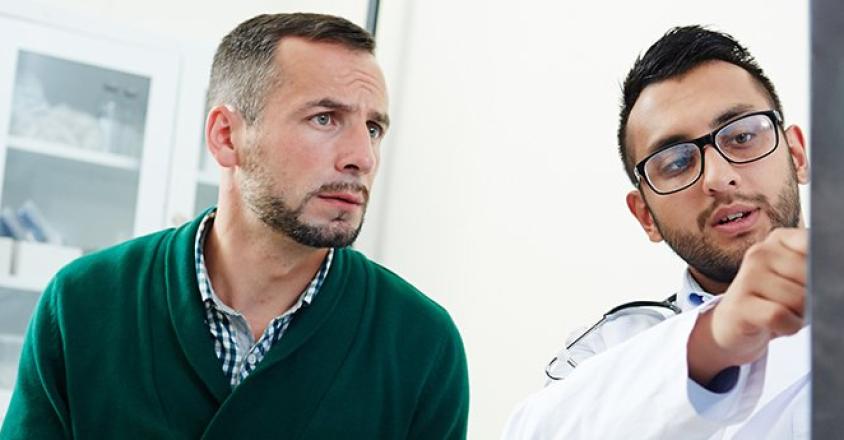
If you have joint pain, it might seem like there’s no relief from persistent aching, stiffness and swelling. But for the over 14 million people living with joint pain caused by arthritis, gaining the knowledge behind what causes the condition can provide the power to overcome it — and live an active, pain-free life.
While arthritis is the leading cause of disability in the U.S. — affecting more than half of all 60-year-olds — arthritis is actually not a single disease. In fact, the term is an informal way of describing around 200 conditions that cause joint pain or joint disease, and arthritis isn’t the only reason for aching joints.
“At about age 25, people have the highest quality and quantity of bone and the smooth, white tissue that covers the bones, or articular cartilage — then everybody declines to some degree due to the normal aging process,” explains Corey A. Jackson, D.O., orthopedic surgeon, Genesis Orthopedic Group. “Some people’s joint health declines faster than others, and there are many factors that will alter how quickly their condition changes.”
To help navigate the why and when of joint pain, it’s important to understand what may be causing the condition. Here are some of the top causes of joint pain you should know:
As the most common chronic joint condition, osteoarthritis (OA) — or degenerative arthritis, or wear-and-tear arthritis — affects 27 million people in the U.S. The disease occurs due to thinning or destruction of the smooth cartilage that covers the ends of the bones, causing changes to the underlying bone. While OA mostly affect those over the age of 60, it can appear even in younger ages. And the risk of OA increases if you’re overweight or you’ve overused a joint through activities, such as sports. The most often OA-affected joints include the knees, hips, lower back and neck, fingers, base of thumb and big toe.
Much less common than OA, rheumatoid arthritis (RA) is a long-term, progressive and disabling autoimmune disease. While RA usually affects the hands and feet first, it can occur in any joint causing inflammation, swelling and pain in and around the joints and other body organs. Often causing stiff joints, RA is estimated to affect over 1.3 million people in the U.S.
Often confused with osteoarthritis, osteoporosis is a very different condition. While OA is a disease of cartilage that causes joint problems, osteoporosis is a disease of the bone. A disorder characterized by decreased bone strength from reduced bone quantity and quality, more than 53 million people already have osteoporosis or are at high risk due to a low bone mass. Women over the age of 50 are the primary targets of osteoporosis; only 20% of cases in the U.S. are men. Osteoporosis causes a loss of bone tissue, leaving bones less dense and more likely to fracture. In addition to resulting in a loss of height and change in one’s posture, the condition can cause severe back pain.
Whether it’s OA, RA or osteoporosis causing your joint pain, the first step to easing the ache is getting an orthopedic surgeon’s evaluation. “The cause of the pain may be something that can be treated very conservatively with medications, activity modifications or physical therapy with excellent relief,” Dr. Jackson says. “But, the decision for a joint replacement is almost exclusively secondary to managing debilitating pain.”
According to the American Academy of Orthopaedic Surgeons, hip, knee and other joint replacement procedures are among the most common elective surgeries in this country. While the average age of patients undergoing hip replacement surgery has declined from over 66 to just under 65, the average age for a knee replacement has also declined from over 68 to just under 65.
For those who are found to need a total joint replacement, numerous advances are effectively easing pain and restoring function, including:
• Quality of the implants and materials used — The combination of advances in prosthetic design and biomaterials improves regained motion, in addition to a joint’s length of life. Overall, today’s joints are lighter and stronger and last longer.
• Real-time computer “navigation” during surgery — A handheld computer navigation unit allows surgeons to be more precise in placing implants, to ensure the best fit and function. Genesis orthopedic surgeons use KneeAlign® during total knee replacement to provide real-time navigation and alignment information throughout your knee surgery. It works through sophisticated micro-sensors, deploying the same precision technology that keeps satellites and space stations in orbit and aircraft straight and level. “It’s like a handheld GPS navigation tool that ensures each joint replacement is patient-specific in terms of alignment,” says Dr. Jackson.
• Patient-specific scanning technology — An advanced and efficient suite of operating room products and technologies known as Arthrex Synergy OR® used at Genesis Orthopedic Services provides ultra-high definition images to let the surgeon know exactly where to make an incision, among other benefits.
While total joint replacement can be effective for an improved quality of life, it’s important to think of the surgery as an option only after all other rehabilitative options are exhausted, according to Dr. Jackson.
“If someone is functioning and their pain is controlled, a total joint replacement is not recommended. But, if all other conservative treatments aren’t effective to relieve pain and immobility, advances have made joint replacement a safe and effective option,” he says.
